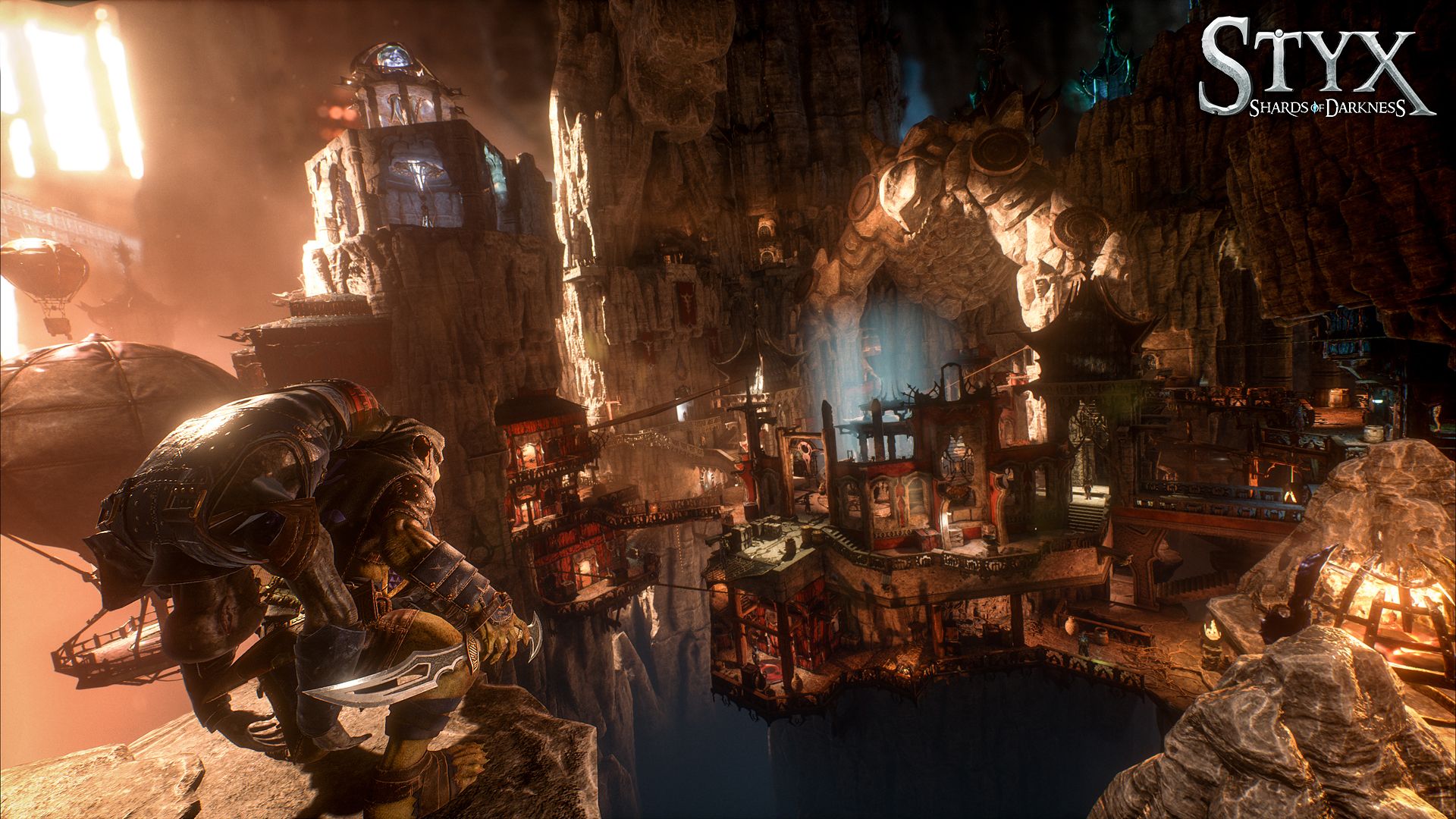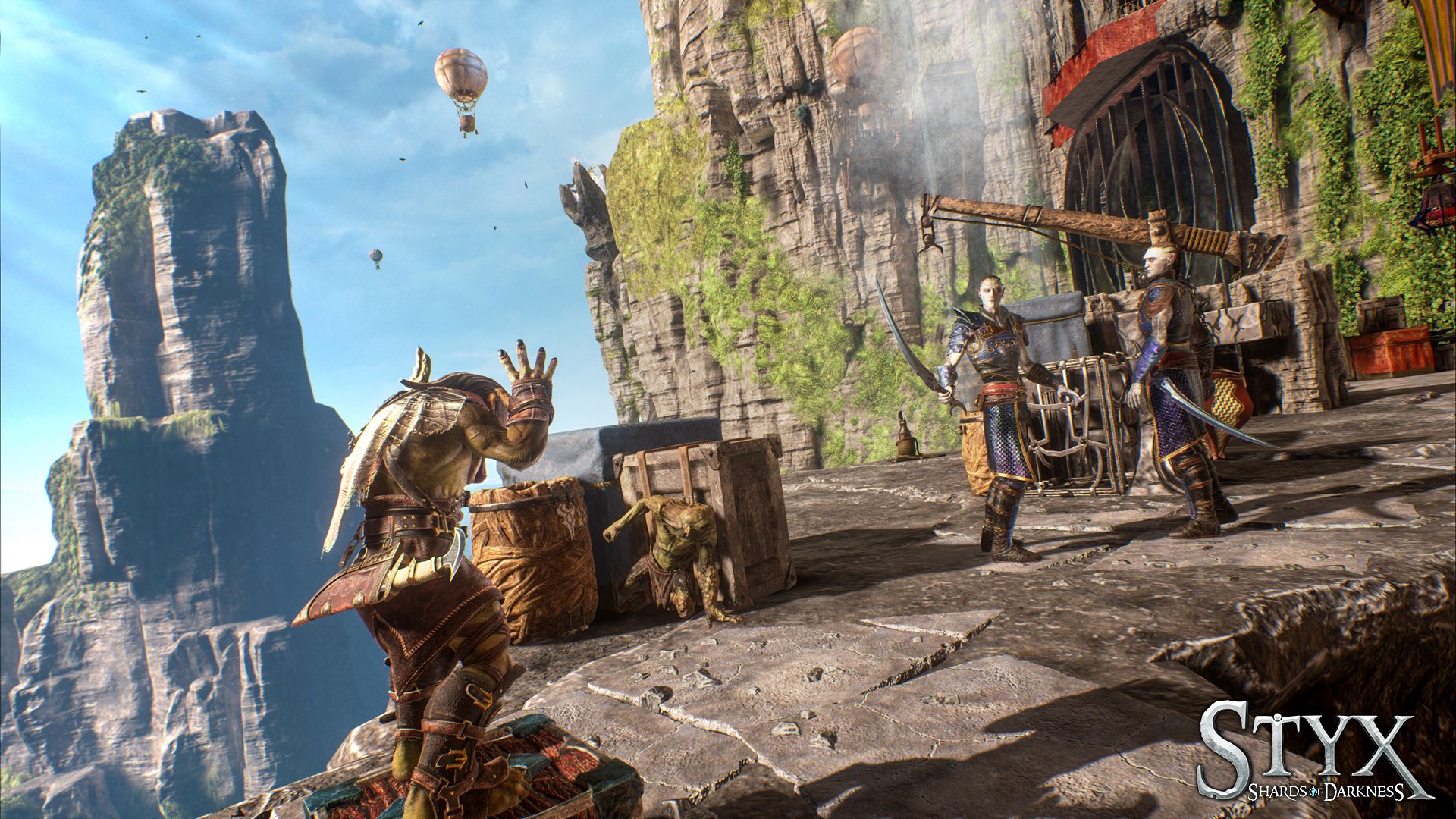Created by Cyanide Studios, and published by Focus Home Interactive, Styx: Shards of Darkness follows the stealthy exploits of a titular and wise-cracking goblin on a personal quest for amber and quartz in a dingy and decaying fantasy world.
Styx’s path of greed entangles him in an ongoing fight with high priestess Lyssril — who is attempting to obtain the power of invincibility through harvesting Amber and acquiring quartz. This story is delivered to us through nine expansive and well-designed levels, all set in or around the elven city of Korrangar. And aside from forgettable lore and some strange AI, there’s a lot to love about this sequel to 2014’s Master of Shadows.
Great Stealth Mechanics and Level Design
Styx is a pure, out-and-out stealth game. When you think ‘stealth’, the first thing that likely comes to mind is not being seen. Right? But recently the trend with these types of games is put an action spin on them to speed the stealth up. Think Batman: Arkham City or Splinter Cell: Blacklist — where you are quick, nimble, but also tough enough to have a big fight.
Styx does away with that, and keeps the game to it’s pure stealth mechanics. Get into combat, and you will be reloading your save pretty quickly.
You, as a sneaky snarky Goblin, must always keep to the shadows. The stealth is tense and methodical — with moments of leaping, clambering, and running that feel so much more satisfying than they otherwise would in a faster-paced action game.
The game’s level design only serves to make that stealth experience even more engaging. In fact, the levels are so well-constructed that I didn’t even realize I was following a waypoint until I made it to my destination. I turned off objective markers and still found my way without any problem. Each world is perfectly streamlined for stealth play — chock full of high areas, crawl spaces, and ledges to clamber around.
Add in the fact that it’s all a breeze to play thanks to thoughtfully designed controls, and you’ve got a hell of a sneaky time.
Unfortunately, the lore in these levels is so forgettable that I can’t say much about it.
While the game puts forth some effort at constructing lore around the characters and places you encounter, it’s easy to ignore it altogether.
There is a fairly refreshing take on elves in a fantasy setting, since Elves in the world of Styx are just as flawed and dark (if not more so) than humans. But other than this subversion of the typical elven archetype, there’s really nothing memorable about the game’s lore. While it’s not really an issue in terms of gameplay or overall quality, it does put a bit of a damper on immersion.
Skill Progression in Styx is Spot On
The lore may not be a strong point, but the natural skill progression of your character is. The game’s upgrade tree doesn’t rely on leveling up, but instead rewards you with points for completing missions and secondary objectives. After playing just the first two missions, I could buy four skills — and that was even without getting any side objectives.
This sort of progression made me feel a lot freer to play the game how I wanted, without being forced to do things just to earn more XP.
It also helps that the upgrade tree is very clear about what each upgrade was going to do. There are no silly names, just good ol’ clear words like “stealth”, “potions”, or “clothing”. This makes working out which skills you want to upgrade much easier, since you don’t need to hunt through the tree to find what you want.
But the AI is Definitely Not All There
Picture this: while walking up some stairs, you find a box in front of you with a guard standing past it. When you pop out from cover, the guard spots you and charges. But instead of running away or countering, you can just breeze right past the angry guard and crouch behind the box before they turn around. Although you’re waiting mere centimeters behind them, the guard has now lost you and goes back to his business. You’ve essentially escaped by playing ring around the rosie.
This wasn’t an isolated incident. I was able to evade detection multiple time using silly tricks like that. Which makes it seem like the AI is either totally oblivious, or simply has a barrier that they can’t cross at times.
Such poor enemy programming spoils an otherwise solid detection system based on the standard three stages of alert. This sort of detection system works just as well in Styx as it has in the numerous other games it’s been used in — it’s just a shame that the enemy AI doesn’t offer more of a challenge once they’ve been alerted.
That said, the clone is a fun little mechanic that makes toying with the AI more fun.
Using amber, Styx is able to create a clone of himself. Doing so can make for a lot of funny moments, especially when you get to screw with the AI and make your clone do ridiculous things.
At times where I had almost been spotted, I could create a clone and kill nearly everyone Rambo-style. Once, I even managed to have my clone distract all the guards and taunt them back toward the start of the whole level, so that the real Styx could stroll right on through.
In Spite of Its Flaws, the Little Things Make Styx a Solid Game
There are lots of little details in this game that make up for its flaws and elevate it above the standard stealth fare. For example, your dagger is your stealth meter — with your Sheath of Night lighting up the more hidden you are. This gives a more natural feeling to the game since you don’t have to look at a HUD or immersion-breaking overlay to see how you’re faring.
As I mentioned earlier, the ease of controlling Styx is also a minor mechanic that makes a huge difference. The simple climbing system minimizes the number of potentially dangerous missteps, and it’s incredibly easy to do things like walk off a platform and drop to the ledge in one swift motion. It feels a lot more fluid than many climbing systems — particularly the “hold the buttons” method from Assassin’s Creed.
Styx also makes lots of nods to other games, like it does toward the Batman Arkham series through its death screens. Where the Batman games had snippets of dialogue performed by the villains who slayed you, you get Styx himself making belligerent remarks. While some feel a bit forced or out of place, most of them are suitably cheesy.
These are all amazing touches that show a great level of care on the part of Cyanide Studios in terms of making the gameplay and overall experience as good as possible.
Overall, Styx: Shards of Darkness is a Hurrah for Stealth Games of Old
While playing Styx, I couldn’t shake the feeling of games like Thief, Hitman, or even the stealth in games like Deus Ex. I’m not saying Styx better than these games, but it does sit right next to them as a game for fans of classic purist stealth.
Styx is a game which makes you think before acting. You study your terrain, get a feel for the guards, and then execute. Getting things right feels amazing. Other than a few let downs with the AI, and lore that wasn’t quite what it could have been, Styx: Shards of Darkness is as masterfully crafted as the titular Styx himself — capable of so much more than his size suggests.
Note: a copy of the game was provided by the publisher for this review.










Published: Mar 12, 2017 01:22 pm